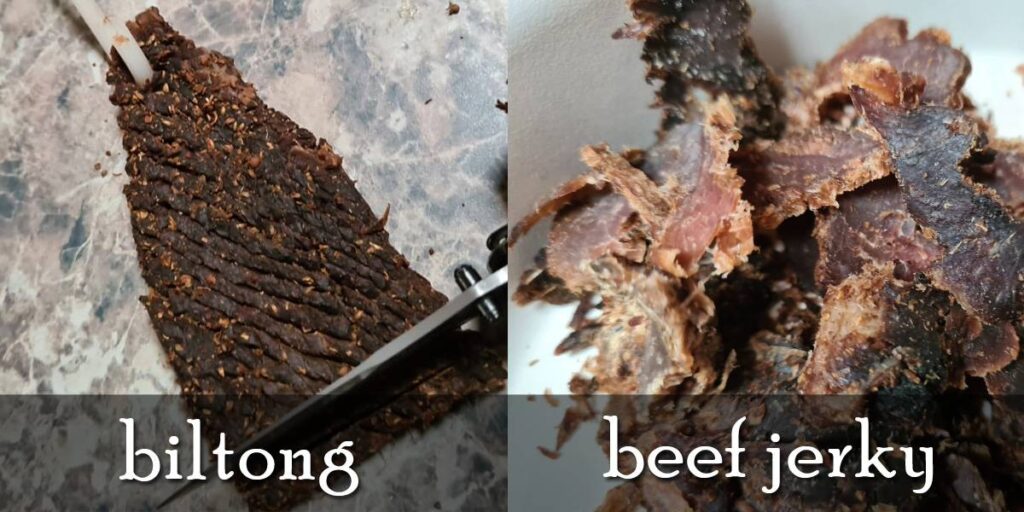Is Salted Beef and Beef Jerky the Same
I am 100% proudly South African. The land of biltong and droë wors. I have had to explicate the divergence to both South Africans and foreigners, as many people think that because they are both dehydrated meats, they are one and the aforementioned products; nonetheless, they are not the aforementioned!
Both biltong and beefiness jerky are made from beefiness, both are dehydrated, and both are succulent! Dehydrated meat lasts for months or even years if it is properly stored. Whether you are a prepper, a hiker, a camper, a football watching burrow lizard, or but a carnivorous savage, biltong or jerky are probably close at hand.

But what are the differences between biltong and beef jerky? Beefiness hasty is made from lean cuts of beefiness, while biltong can be made from fatty cuts. Beef jerky is seasoned and immediately dehydrated, while biltong is marinated, and hung on hooks to air dry. Hasty has a smokey sense of taste, while biltong has a meaty sense of taste.
What is the departure between biltong and beefiness jerky?
As yous can see, the differences between biltong and jerky are based in the preparation, flavoring agents, and the different procedures used to make each.
Here is a side-by-side guide to the differences between biltong and beefiness jerky.
| Biltong | Beef Jerky |
|---|---|
| Originally from South Africa | Originally from South America |
| Simple tastes with common salt equally the main flavoring; sometimes spiced with peri peri, barbeque spices, or home-made blends of spices | Wide range of flavors based on and fabricated with sauces and spices to be sugariness or salty |
| Biltong has a lower sugar content, but a higher sugar content | Beef jerky has less common salt but more sugar |
| Tin be made from lean or fat cuts every bit per desired taste | Made from very lean cuts of beef |
| Seasoned with table salt, vinegar, and simple spices | Seasoned with sauces and spices |
| Marinated for 24 hours before dehydration begins | Meat is seasoned and immediately dehydrated |
| Slightly acidic gustation due to the absorption of the vinegar during the marinating or curing process | Sweetness, smoky, sticky gustation and texture |
| Considering of the simple spices, biltong has a very compact taste | Because of the cooking process used to dehydrate the meat and all the sauces and spices that season the meat, hasty has a very smokey taste |
| The texture varies according to fat content; lean biltong is dryer while biltong with a college fat content is softer and can be chewy; biltong can contain more fifty% of fat | Because at that place is very fiddling fat on the meat, jerky is tougher to chew |
| Biltong can vary from the same thin cuts jerky uses to very thick – one or more inches thick – large chunks of meat | Jerky is thinly cut or thin strips of meat |
| Hung on hooks to air dry for i to 3 weeks depending on the thickness of the cut and how moisture the consumer likes his or her biltong to be (rare, medium rare, or well done – dry); this is ofttimes done in a dehydration box with a fan and a light to go along flies off of the meat | Cooked at low temperature in the oven or dehydrator to slowly dehydrate for 3 to 12 hours |
| Made from beef, venison, or ostrich | Made from beefiness, but – if y'all want to stray from meat – information technology also tin be made of mushroom, cactus, soy, coconut, or bacon |
Biltong is fabricated with thick or thin cuts of beef (although it can exist fabricated with other meats) that are marinated for 24 hours before being hung up to air-dry.
The marinade is made of very simple, basic flavors including vinegar, table salt, white or black pepper, and spices to taste. The meat is preserved by the vinegar and common salt. The process takes 1 to 3 weeks. It typically has a higher fat content than jerky.
Beef hasty is made of very thin cuts of lean beefiness or strips of beefiness, seasoned with sauces and spices to taste and then cooked or dehydrated at very low rut for 3 to 12 hours – much faster than making biltong. In addition to the rut from the oven and dehydration, the meat picks up preservatives found in the sauces.
Quick Recipes
I am giving you two of my own recipes here. But I have not put amounts of ingredients, partly considering I accept been doing this for then long that I have gained my ain guiding star for the quantities needed, and partly because the amount of each ingredient is non of any result.
To brand hasty, y'all are but coating the meat, then you do non need much marinade. The master preservative is found in the unlike sauces – they are non all natural, they contain preservatives.
To make biltong, you volition need to make plenty to soak the meat, the only liquid typically used in South African biltong is the vinegar and then yous will need enough to most encompass the meat, with the other spices added in to taste. The vinegar and the salt are what preserves the meat.
Here is a basic recipe for you to try to brand delicious beef jerky:
Mix together in a bowl:
- Soy sauce
- Salt
- Barbeque sauce
- Spices to taste
- Dark-brown sugar
Dip the thinly sliced pieces or strips of beef into the marinade. Coating both sides thoroughly.
Place the beef on a rack in the oven with the oven on its everyman estrus setting. Cheque on it after 2 ½ hours to monitor information technology until it is dehydrated to your preference. Yous can bank check a full biltong recipe hither.
Hither is a basic recipe for biltong:
Mix together in a marinade dish:
- Vinegar
- Common salt
- Black pepper
- Coriander
- Red pepper
- Mixed spices
Place the beef cuts in the marinade dish to soak for 24 hours. Turn the marinade dish over every ii to three hours (when you are awake) to ensure the meat is thoroughly soaked on both sides and between all the nooks and crannies betwixt cuts of meat.
Remove the meat from the marinade, and place hooks in the individual pieces or skewer the pieces on a kabob stick.
Hang the meat in a dehydrator (with a good fan and light for heat and air move). Leave the meat to dehydrate for one to 3 weeks (bank check the meat frequently to ensure that if yous adopt your biltong to be rare you do non exit it in the dehydrator for too long; if yous prefer your biltong to exist very dry out, get out it in the dehydrator until information technology is no longer springy when you squeeze information technology).
Determination
Both are good for you snacks – sugar and salt bated – as they are a bright source of protein. Dehydrated, they are edible long later on they have been made. They tin both be vacuum sealed and and then frozen and removed from the deep freeze as needed, or and stored in a cool, dry place.
They are both very piece of cake to brand and convenient for long term storage. They are perfect for stockpiling, or to utilize leftover uncooked meat as your ducklings wing the coop and you lot are adjusting buy portion sizes (i.e. you lot still store for v fifty-fifty though there are only 3 living permanently in your home).
They are both convenient, tasty treats that are perfect for whatsoever occasion.

Di-Anne Devenish Seebregts was raised in an environment where daily life consisted of hiking, environmental conservation, growing fruit and vegetables, and raising poultry for meat and eggs.
She combined her passion for the writing discussion with her dear of the pride that comes with not relying on others. She raised 3 children (who are now adults) to value the environs, and understand the value of being self-sufficient.
Source: https://thehomesteadinghippy.com/biltong-vs-beef-jerky/
0 Response to "Is Salted Beef and Beef Jerky the Same"
Post a Comment